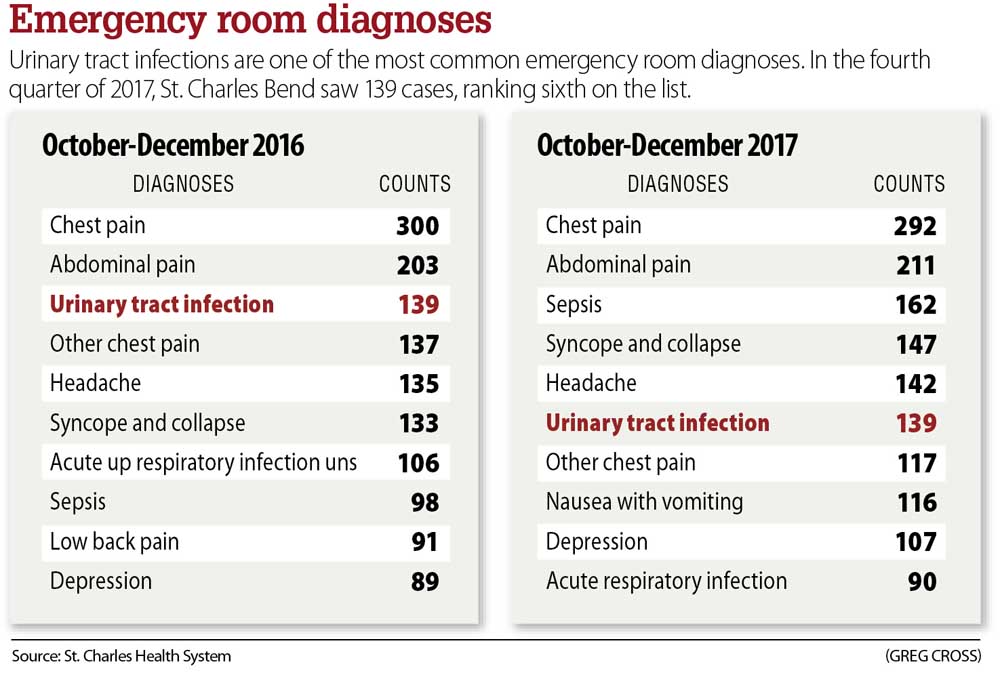Urinary tract infections often misdiagnosed
Published 12:00 am Friday, May 11, 2018

- Urinary tract infections often misdiagnosed
Every day in the emergency room at St. Charles Bend, someone is diagnosed with a urinary tract infection. It’s among the most common diagnoses seen at the hospital, particularly among elderly women.
From October to December of 2017, St. Charles Bend treated 139 patients for urinary tract infections, the sixth most common diagnosis over those three months. In the same quarter of 2016, an identical number of cases ranked third on the list.
Trending
But many doctors are concerned the condition may be misdiagnosed, that physicians are too quick to rely on the result of a lab test and overlook other possible explanations of a patient’s symptoms.
“You try to find something you can treat,” said Dr. Gillian Salton, an emergency physician at St. Charles Bend. “So if we have a urinalysis that looks suspicious and somebody has symptoms that could be attributed to a UTI, we can say, ‘Oh look, I found something I can fix.’”
Generally, doctors who suspect an infection will order a urinalysis test, which provides a quick indication whether there are white blood cells in the patient’s urine. Urine is normally sterile, so the presence of white blood cells could be a sign of infection.
“Part of the challenge is that not everybody who has white blood cells in their urine has a UTI,” Salton said. “There’s probably a bit of overcall.”
She says ER doctors will often order a “urinalysis with culture as needed,” which tells the lab to go ahead and culture the urine if white blood cells or bacteria are found in the initial test. Urine cultures — where laboratory technicians seek to grow the germs in urine until they can be identified under a microscope — are more accurate tests, but require one to three days for results. By that time, the patient has usually left the hospital and probably started taking antibiotics.
The American College of Emergency Physicians cautions that no single symptom or lab test is accurate enough to confirm or rule out a urinary tract infection. About half of patients with symptoms, such as painful or frequent urination, actually have an infection. The rate goes up to 90 percent if patients don’t have symptoms such as vaginal irritation, bleeding or discharge.
Trending
But there is also a multitude of ways urine samples can get contaminated during collection. “Urine specimens, particularly female urine specimens, go through the genital area, and they can pick up genital bacteria,” Salton said. Those samples won’t culture in the same way as an infection, but it could fool the urinalysis test.
Urine cultures have a 5 percent false-positive rate, as some people have bacteria in their urine without experiencing any symptoms of an infection.
All of those factors make urinary tract infections particularly difficult to diagnose, especially under the time constraints of the ER.
A 2015 study from researchers at Case Western University tested urine samples from 264 women who had come to the ER with symptoms suggestive of a urinary tract infection. In total, 92 percent of the women had abnormal urinalysis results, but only 48 percent ended up with a positive urine culture.
“Less than half of women diagnosed with a urinary tract infection actually had one,” Dr. Michelle Heckert said in a statement on the study. “Sexually transmitted diseases were missed in 37 percent of the women, many of whom were wrongly diagnosed with urinary tract infections.”
That’s a particular concern in Central Oregon, where rates of sexually transmitted diseases have been on the rise. Urinary tract infections and sexually transmitted diseases have overlapping symptomatology, including painful, frequent or urgent urination, and both can lead to white blood cells in the urine.
The high number of urinary tract infections in emergency rooms may also underscore the lack of access to timely primary care services. More than 1 million urinary tract infections are diagnosed in emergency departments each year, and a recent study found 1 in 4 elderly visits to the ER was for a urinary tract infection.
But Salton cautioned that urinary tract infections can run the gamut from a condition with minimal symptoms to cases where the patient is close to death. In between are a lot of cases where the patient just can’t wait until the morning.
“They are extraordinarily uncomfortable,” she said. “It feels like an emergency.” •








